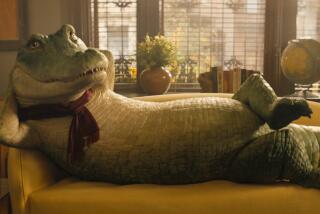‘Lion King’: Roar of Approval
In the animated “The Lion King,” an African lion-cub prince named Simba is driven from his home by a scheming uncle after his father dies, grows up with a pair of eccentric jungle animals and later returns to claim his throne and find true love. (Rated G)
They know “Aladdin,” “Beauty and the Beast” and “The Little Mermaid.” They’ve been inundated with pre-release publicity and commercial ads for “Lion King” paraphernalia. And yet, many children said the movie was still more than they had expected.
“I didn’t know it would be so emotional,” said Bret Larson, 8.
Animation works its magic on the heart as well as the eye here, exaggerating all the expressions of parental love, raw animal fear and the eternal ambivalence of filial devotion and guilt.
Said to be the “Bambi” of the ‘90s, “The Lion King,” has stirred up controversy--particularly over scenes involving violence and pop psych solutions. In one, Simba watches his father, Mufasa, being killed by a herd of stampeding wildebeests. In another, lions and hyenas battle long and fiercely. And in yet another an adult Simba and his Uncle Scar engage in mortal lion combat.
Most parents will probably know whether the intensity will upset their young children. The reaction among kids was generally positive.
One father, whose 3-year-old came out shrugging his shoulders, said he thought the 87-minute movie was too long. But another said his 2-year-old was enraptured.
“He’s a very active kid, so we were a little apprehensive,” said Fred Gerardi of his son, Steven. “He never came out once. He stayed the entire time. The only thing he could tell me when he came out was ‘Scar was bad.’ ”
Most older kids, accustomed and in some cases attracted to cartoon violence, said they liked it.
“It was good,” said Brian Whitesides, 12, who along with his friends Josh Wernet and Ken Man, both 13, liked the fighting-lion scenes the best.
Reactions were often split along gender lines, with the boys liking the action and the girls liking the relationship between Simba and the girl cub who grows up from his playmate to his mate.
Five-year-old Alaina Moreno, who came to the show wearing her Jasmine costume from “Aladdin,” said her favorite part was “when the boy and the girl got married and they had the baby.” She “almost” cried in the movie, she said, but still preferred it to “Aladdin” because “it was so good.”
Older kids, familiar with psych talk, said they were not put off by the movie’s themes of self-esteem, communicating and sharing feelings.
“I liked the movie because I thought it was interesting and showed kids different ways of looking at things,” said Katherine Kleveland, 10. “Like how the dad taught the son, and, like, the dad was always with the son (even after he died) and told him what to do. I thought it was cute how the dad and the son related to each other.”
Her sister Margaret, a more worldly 13, had a slight suspension of disbelief problem.
“It wasn’t as good as I expected it to be,” she said. “It was just, like, really unrealistic. It could never happen.”
Ten-year-old Heather Schieve’s had only one complaint. “I thought it was a little too soon in the movie for that father to die. Usually, something sad or someone dies later in the movie. Other than that, I thought it was great.”
I wonder if anyone else is bothered by what seems a trend in animated films to ram home stereotypes that might be avoided elsewhere. The heroes and heroines always seem to speak unaccented American English while the villains and varmints speak with foreign or ethnic accents.
But Katherine thought the voices were simply fun.
And to the certain delight of investors in the movie, she plans to become a consumer of “Lion King” stuff. Her favorite scene was when the baboon witch doctor holds up the baby Simba for the approval of the village.
“I thought it was really pretty and really cute,” she said. “I might get a poster . . . of that picture.”
More to Read
The biggest entertainment stories
Get our big stories about Hollywood, film, television, music, arts, culture and more right in your inbox as soon as they publish.
You may occasionally receive promotional content from the Los Angeles Times.










